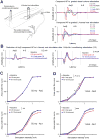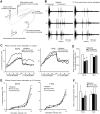Conventional and kilohertz-frequency spinal cord stimulation produces intensity- and frequency-dependent inhibition of mechanical hypersensitivity in a rat model of neuropathic pain
- PMID: 23880991
- PMCID: PMC3763697
- DOI: 10.1097/ALN.0b013e31829bd9e2
Conventional and kilohertz-frequency spinal cord stimulation produces intensity- and frequency-dependent inhibition of mechanical hypersensitivity in a rat model of neuropathic pain
Abstract
Background: Spinal cord stimulation (SCS) is a useful neuromodulatory technique for treatment of certain neuropathic pain conditions. However, the optimal stimulation parameters remain unclear.
Methods: In rats after L5 spinal nerve ligation, the authors compared the inhibitory effects on mechanical hypersensitivity from bipolar SCS of different intensities (20, 40, and 80% motor threshold) and frequencies (50, 1 kHz, and 10 kHz). The authors then compared the effects of 1 and 50 Hz dorsal column stimulation at high- and low-stimulus intensities on conduction properties of afferent Aα/β-fibers and spinal wide-dynamic-range neuronal excitability.
Results: Three consecutive daily SCS at different frequencies progressively inhibited mechanical hypersensitivity in an intensity-dependent manner. At 80% motor threshold, the ipsilateral paw withdrawal threshold (% preinjury) increased significantly from pre-SCS measures, beginning with the first day of SCS at the frequencies of 1 kHz (50.2 ± 5.7% from 23.9 ± 2.6%, n = 19, mean ± SEM) and 10 kHz (50.8 ± 4.4% from 27.9 ± 2.3%, n = 17), whereas it was significantly increased beginning on the second day in the 50 Hz group (38.9 ± 4.6% from 23.8 ± 2.1%, n = 17). At high intensity, both 1 and 50 Hz dorsal column stimulation reduced Aα/β-compound action potential size recorded at the sciatic nerve, but only 1 kHz stimulation was partially effective at the lower intensity. The number of actions potentials in C-fiber component of wide-dynamic-range neuronal response to windup-inducing stimulation was significantly decreased after 50 Hz (147.4 ± 23.6 from 228.1 ± 39.0, n = 13), but not 1 kHz (n = 15), dorsal column stimulation.
Conclusions: Kilohertz SCS attenuated mechanical hypersensitivity in a time course and amplitude that differed from conventional 50 Hz SCS, and may involve different peripheral and spinal segmental mechanisms.
Conflict of interest statement
Figures



Comment in
-
Spinal cord stimulation: does frequency matter?Anesthesiology. 2013 Aug;119(2):243-4. doi: 10.1097/ALN.0b013e31829bd9fb. Anesthesiology. 2013. PMID: 23838719 No abstract available.
References
-
- Linderoth B, Meyerson BA. Spinal cord stimulation: Exploration of the physiological basis of a widely used therapy. Anesthesiology. 2010;113:1265–7. - PubMed
-
- Meyerson BA, Linderoth B. Mode of action of spinal cord stimulation in neuropathic pain. J Pain Symptom Manage. 2006;31:S6–12. - PubMed
-
- Guan Y. Spinal cord stimulation: Neurophysiological and neurochemical mechanisms of action. Curr Pain Headache Rep. 2012;16:217–25. - PubMed
-
- Lind G, Schechtmann G, Winter J, Linderoth B. Drug-enhanced spinal stimulation for pain: A new strategy. Acta Neurochir Suppl. 2007;97:57–63. - PubMed
-
- Yang F, Carteret AF, Wacnik PW, Chung CY, Xing L, Dong X, Meyer RA, Raja SN, Guan Y. Bipolar spinal cord stimulation attenuates mechanical hypersensitivity at an intensity that activates a small portion of A-fiber afferents in spinal nerve-injured rats. Neuroscience. 2011;199:470–80. - PubMed
Publication types
MeSH terms
Grants and funding
LinkOut - more resources
Full Text Sources
Other Literature Sources
Medical

